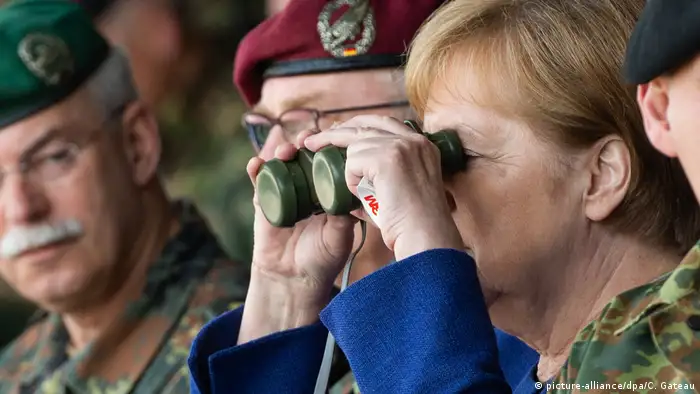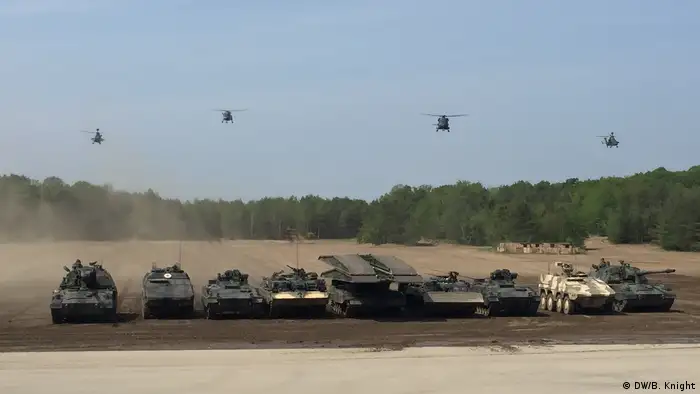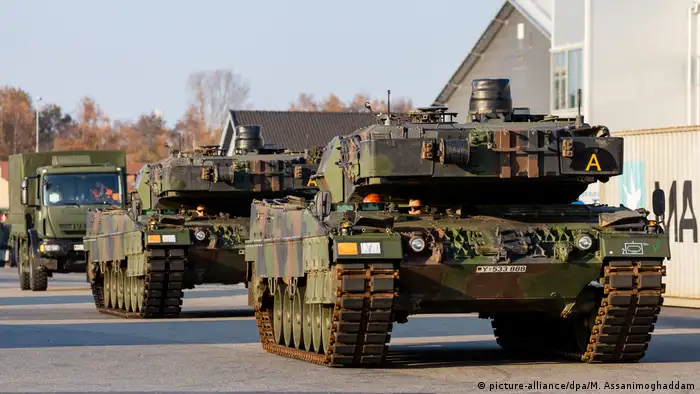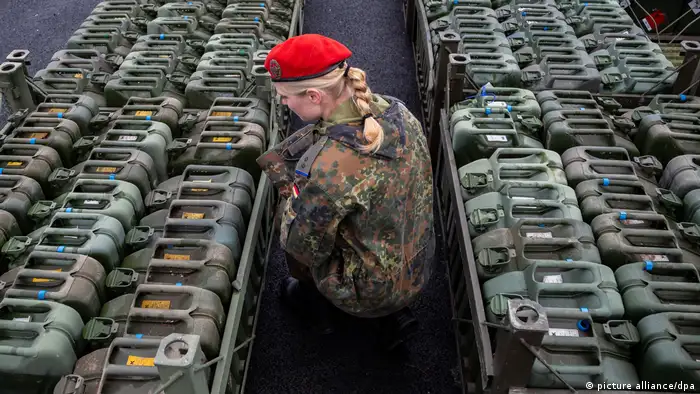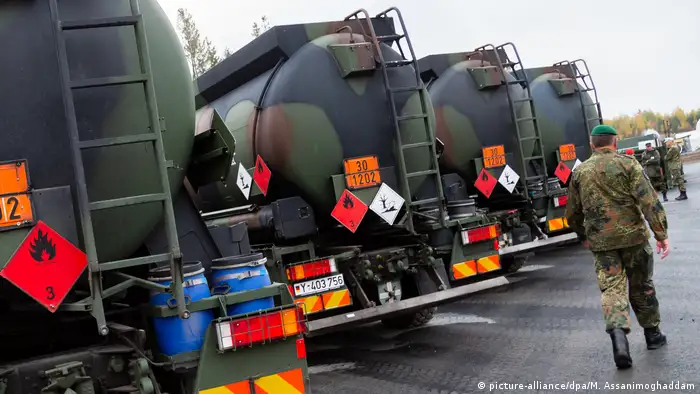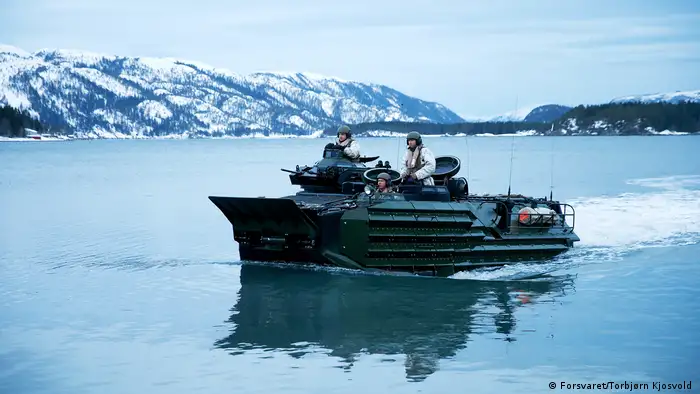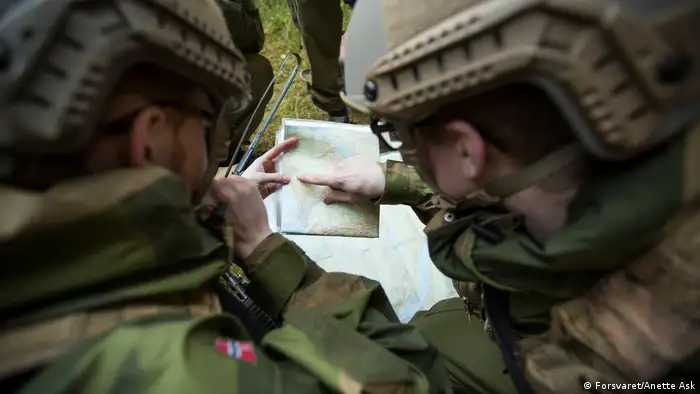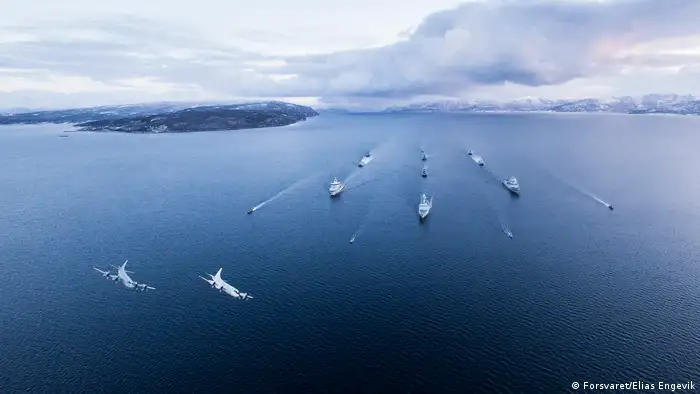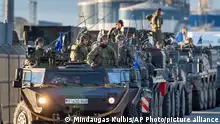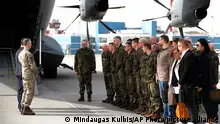Germany
Angela Merkel inspects NATO troops in Germany
The German military has put on a major display for the chancellor to show off its NATO commitment. Speaking to soldiers, Angela Merkel underlined the importance of showing the alliance was ready to defend its territory.
Chancellor Angela Merkel was treated to the full military works in Munster on Monday, on a visit to the Bundeswehr's 9th Armored Demonstration Brigade, which is this year providing the ground forces for NATO's Very High Readiness Joint Task Force (VJTF).
Much of the major hardware the Bundeswehr has to offer took part in a coordinated half-hour display, which the chancellor watched through binoculars alongside General Eberhard Zorn, the highest ranking German soldier, and Lieutenant General Jörg Vollmer, chief of staff of the German army.
Read more: NATO tries to prevent an arms race
The display itself involved reenactments of ground assaults involving multiple armored vehicles, complete with tanks crossing water-filled ditches, helicopter rescues and in-flight refueling operations. Tiger helicopters, Tornado fighter planes, several Leopard 2 battle tanks, as well as amphibious armored vehicles, motorcyclists and bridge-building trucks, all took part, firing blank ammunition.
Merkel herself arrived at the parade ground in an Enok military police vehicle, before posing for a number of photos in front of various ranks of soldiers and pieces of heavy equipment. She also had lunch with some of the soldiers.
Political significance
This was the chancellor's first visit in seven years to Munster, the biggest German army base in the country and home to more than 5,000 military personnel. In a brief address following the display, Merkel touched on the political importance of the VJTF, which NATO founded in 2015 as a direct response to the war in eastern Ukraine, and the potential Russian aggression on the alliance's eastern borders.
Since 2012, she said, the "political task has of course completely changed.
"With what we experienced [in Ukraine], a new situation has emerged that has made the defense of the alliance's own territory a priority once again," she said.
"The capabilities that we put on the scales are a contribution so that others know we are serious about defending our territory," Merkel said. "And that is why the possibilities of negotiations are opened. That means talking about peace is not enough; we have to prove that we are ready to defend that peace."
"We know that the establishment of the VJTF came in connection with the events of 2014," Lieutenant Colonel Michael Wagner, commander of the 93rd armored battalion, told DW. "That is why we take the mission especially seriously. We also know that beyond that we are to create a deterrence effect."
The VJTF includes soldiers from nine European NATO partners, including France, the Czech Republic, Lithuania, and Latvia — the latter having a particular interest in protecting themselves from what they see as the ever-present Russian threat. Norwegian, Dutch and Belgian officers were also on hand for the display on Monday, and Norway last year played host to the largest NATO military exercises in its history.
But the brigade still needs to be renewed for the digital age. The soldiers said a major overhaul was being planned over the next few years that will include making sure soldiers can be tracked with GPS devices during operations, and an upgrade of the digital communication between the various international forces also expected.
"There is material coming, and it is getting to the soldiers, and it really is good for my soldiers when they see that something is happening," said Wagner, who was keen to underline the progress that had been made despite reports of equipment shortages in the Bundeswehr.
The chancellor's visit was "a great honor for us, and reflects the status that this VJTF has for her," Wagner added.
Read more: NATO steps up naval presence on the Black Sea
Ready for Russia
The exercise was an opportunity for the military to show the chancellor how important Germany's practical commitment to NATO is: the military's advance press statement said the VJTF duties "required permanently available material," a rather pointed comment given the Bundeswehr's much-publicized problems in finding reliable hardware.
The Bundeswehr has repeatedly called for more financial resources, most recently last Friday, when a Defense Ministry spokesman said the German military "was a force that for many years had to make do with dwindling budgets and shrinking structures." Those calls have been supported by pressure from NATO allies, particularly the US, to meet the alliance's defense budget target of 2% of GDP.
The 2019 German defense budget is €43.2 billion, some €5 billion more than last year, and Merkel did not miss the opportunity on Monday to underline the "significant increase" in military funding. But it's still some way below the 2% target, though Germany's financial contribution to NATO also comes out of the budgets of other ministries, for instance when non-German NATO soldiers are housed on German soil.
Merkel mentioned the importance of the brigade to NATO, too. "For us it becomes politically clear again that it's nice when we can fulfil our alliance duties with this brigade," Merkel told the soldiers.
DW recommends
Audios and videos on the topic
- Date 20.05.2019
- Author Ben Knight (Munster, Germany)
- Related Subjects Russia's partial mobilization, Merkel’s Era: The Women of Power , Ukraine, Black Sea, BRICS, Angela Merkel, Russia, Dmitry Medvedev, Bundeswehr, NATO
- Keywords NATO, Angela Merkel, troops, Bundeswehr, Russia, Ukraine
- Feedback: Send us your feedback.
- Print Print this page
- Permalink https://p.dw.com/p/3In8O
- Date 20.05.2019
- Author Ben Knight (Munster, Germany)
- Related Subjects Russia's partial mobilization, Merkel’s Era: The Women of Power , Ukraine, Black Sea, BRICS, Angela Merkel, Russia, Dmitry Medvedev, Bundeswehr, NATO
- Keywords NATO, Angela Merkel, troops, Bundeswehr, Russia, Ukraine
- Send us your feedback.
- Print Print this page
- Permalink https://p.dw.com/p/3In8O

